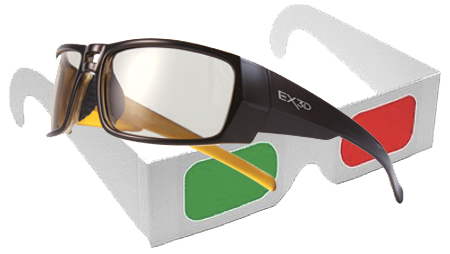
There is no doubt that 3D movies are here to stay. The people who do such things came to CinemaCon, the annual gathering of that National Association of Theater Owners, attended by exhibitors, studios and manufacturers of movie going accoutrements from seats to snacks, to tell those in attendance what others changes are being brought by 3D.
For example, back in the day, 3D movies were projected on any old screen that happened to be hanging in the theater. Now, however, screens are specialized for exhibiting digital and 3D film.
Harkness Screens, based in the UK, has been manufacturing movie screens since 1929. Now, company representatives say their technology is moving at a rapid pace to simplify projection -- less color correction as the projector is being set up -- and improve the viewer's experience. Thus, they introduced their Perlux® Digital 2D and 3D screen.
One reportedly negative aspect of watching a 3D --reported by several speakers at CinemaCon -- is the darkness of the screen. Now, James Cameron did say that digital cinematography, which increases the number of frames shot per second in a film, will make the film brighter. And, say the people at Harkness, so will their newest screen that is brighter than any others.
Of course, as audience members not involved in any aspect of theater ownership or operation, most of us seem to either really like or dislike 3D movies. In January, film critic Roger Ebert posted an entry in his Chicago Sun-Times blog titled "Why 3D doesn't work and never will. Case closed."
In it, he reported on a letter he got from multi-award-winning film editor Walter Murch, who said, "The 3D image is dark, as you mentioned (about a camera stop darker) and small. Somehow the glasses "gather in" the image -- even on a huge Imax screen -- and make it seem half the scope of the same image when looked at without the glasses."
In his letter, the film editor also confronted the claim by many 3D proponents that the 3D experience is "immersive," making the viewer feel almost a part of the film. He concluded, "3D films remind the audience that they are in a certain 'perspective' relationship to the image...Whereas if the film story has really gripped an audience they are 'in' the picture in a kind of dreamlike 'spaceless' space. So a good story will give you more dimensionality than you can ever cope with.
"So: dark, small, stroby, headache inducing, alienating. And expensive. The question is: how long will it take people to realize and get fed up?"
A 2010 survey by the International 3D Society concluded that demand and preference for 3D is very high, although six in 10 adults (59 percent of those surveyed) have yet to see a 3D movie.
If those who haven't seen a 3D movie wait a few months their view promises to be greatly improved. That is because a new age of 3D glasses is about to dawn. Long gone are the red and green cellophane lenses in cardboard frames.
At CinemaCon Polaroid gifted each CinemaCon attendee with a pair of their Premium 3D Glasses that can fit over most regular eyeglasses, Marchon 3D has taken the looks, comfort and versatility of these glasses to a new level.
The company now manufactures a range of 3D eyewear, including sleek, seamless clip-on 3D glasses for those who must wear prescription lenses to watch a movie. Their lenses are kind of impressive. The company has patented a circular, curved lens that react extremely fast to light conditions. They are scratch-resistant and are polarized so they can be worn indoors and out as, one would expect, can the 3D glasses from Polaroid. Marchon 3D also gives the 3D consumer the option of buying designer frames from Nautica and Calvin Klein ($150 and $180, respectively).
With all of these advances in eyewear technology and style in place, Marchon 3D is about to take a final step, one that will most radically change 3D eyewear.
But, by the end of the year, teaming with Younger Optics, they will make available prescription 3D glasses. (Both of these manufacturers work with RealD technology, the most prevalent in 3D movie houses today.)
In seeing all this at CinemaCon it was difficult not to be impressed. But, there is one more thing, one more innovation, many look forward to seeing., As noted, in the coming months and years, we will see improved technology on the screen and for the viewer. Soon, it is to be assumed, viewers who are comfortable with the screens and glasses required for 3D, will begin to demand the highest quality of movies. Today, in general when it comes to films in 3D, we seem to get big and bigger films -- big noise, bigger effects. Now, maybe, someone will figure out that bigger isn't always better and begin to give us a variety; smaller films with more depth of thought to go with the depth of image.
Photo: Marchon EX3D glasses courtesy of the manufacturer. Red and green 3D glasses circa 1953, as used to view the original House of Wax.